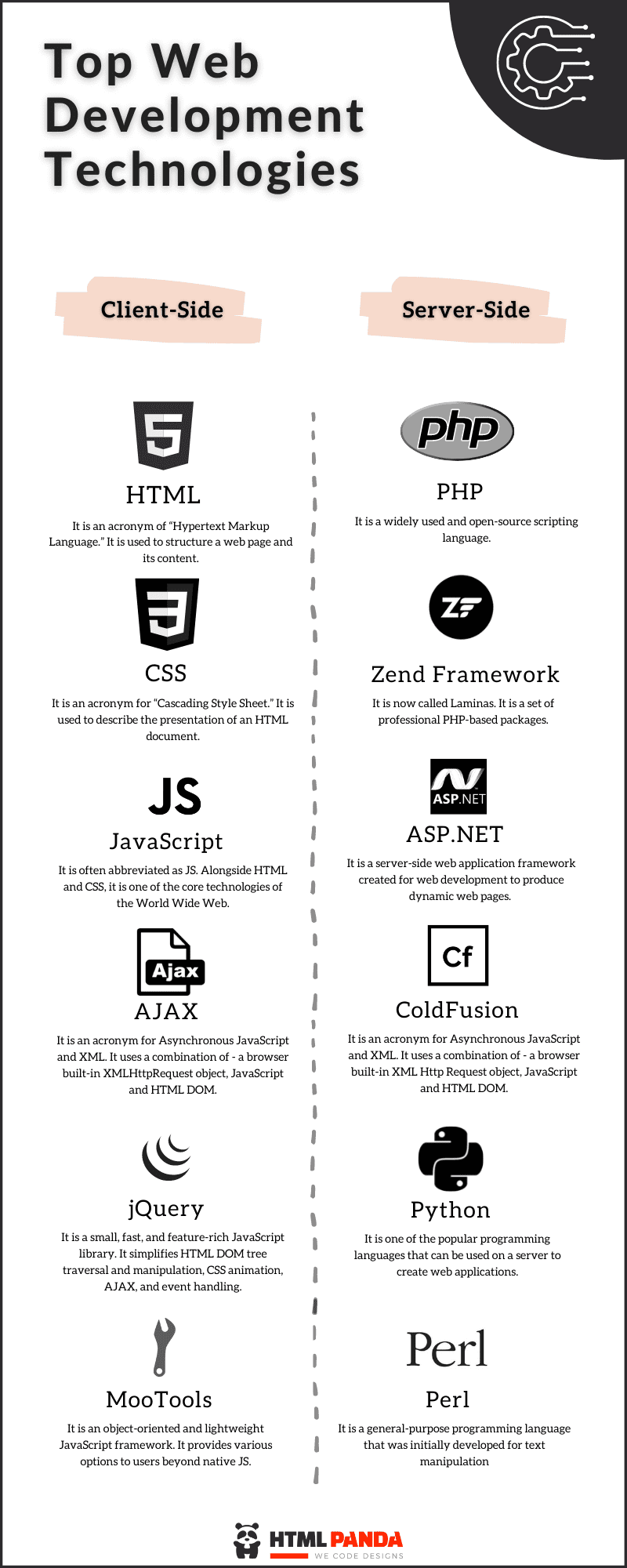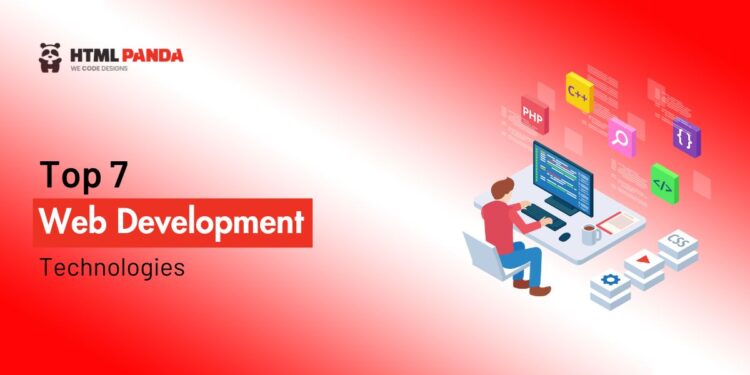Your web development project goals may include performance, design, user experience, and a lot more.
So, the question is not to choose the best among many web technologies available in the market but to find the one that complies with your website requirements.
Here, we have discussed the top web technologies that will ideally work for your business.
Best Web Development Technologies To Use in 2024
Mainly there are two types of coding, scripting, and programming for creating web applications: Client-side and Server-side.
Client-Side Web Development Technologies
Client-side coding is a kind of code that is interpreted by browsers. It is usually viewable by any visitor to the site.
Some of the standard client-side scripting technologies are –
- HTML – It is the standard markup language for documents designed to be displayed in a web browser.
- CSS – It is a style sheet language that describes the document’s presentation written in markup language. It also enables the separation of content and presentation, including layouts, colors, and fonts.
- JavaScript – It is a loosely typed, compact language generally used by web developers. It enables client-side interactivity and has become widely adopted in recent years because new frameworks and best practices have increased.
- AJAX – It is a collection of web development techniques that uses various client-side web development technologies to create asynchronous web applications.
- jQuery – It is a JavaScript library that simplifies the HTML DOM tree traversal and manipulation. Along with that, it also simplifies event handling, CSS animation, and AJAX.
- MooTools – MooTools (or My Object-Oriented Tools) is a lightweight, open-source, object-oriented JavaScript framework. This framework includes built-in functions for manipulating CSS, DOM elements, AJAX requests, JavaScript objects, etc.
- Dojo Toolkit – This is an open-source modular JavaScript toolkit designed to ease the rapid development of cross-platform. It is a JavaScript framework that targets the many needs of large-scale client-side web development.

Server-Side Web Development Technologies
Server-side scripting is the type of code that is interpreted on the web server. It is not accessible or viewable to any visitor.
- PHP – It is a popular, open-source scripting language that is free to download and use. The code of PHP is executed on the server, and the result is returned to the browser as plain HTML.
- Zend Framework – It is a set of professional PHP packages that are now called Laminas and implemented in PHP7. It is an open-source, object-oriented web application framework.
- ASP.NET – This server-side web application framework is open-source and designed for web development for creating dynamic web pages.
- ColdFusion – It is Adobe’s commercial rapid web-application development computing platform. It was initially designed to make it easier to connect simple HTML pages to the database.
- Ruby on Rails – This server-side web application framework is written in Ruby. This MVC (Model-View-Controller) framework provides default structures for a database, a web service, and web pages.
- Python – This is a general-purpose and high-level programming language that supports multiple programming paradigms, including object-oriented, functional, and structured programming.
- Perl – This general-purpose programming language was initially developed for text manipulation. It is now used for various tasks such as system administration, web development, GUI development, etc.
A dedicated web development company can work on all the above-mentioned technologies. You can analyze your requirements and budget and make the best deal for your website development project.
Also Read: Comprehensive Guide to Full Stack Web Development
Most Popular Web Development Frameworks
A web application framework offers an extensive range of code snippets and pre-written components. These frameworks can not only reduce the code but also increase your productivity.
Client-Side Web Development Frameworks
- Ember – It is an open-source JavaScript framework that allows developers to create scalable single-page web applications. It is an older framework with fewer users, but it still has fair popularity because of its stability, community support, and coding principles.
- Angular – It is an open-source web application framework led by the Angular team at Google. It is a component-based framework that uses declarative HTML templates.
- Vue – It is an open-source model-view front-end JavaScript framework to build user interfaces and single-page applications.
- React – This open-source front-end JavaScript library builds user interfaces based on the UI components. React can be used as a base for creating mobile or single-page applications.
Server-Side Web Development Frameworks
- Django – It is a high-level Python web framework that motivates clean, pragmatic design and rapid development. As it is Python-based, its code is easy to read and maintain. Moreover, it is fast, secure, and scalable.
- Flask – It is stated as the micro web framework written in Python. It is categorized into microframework because it does not need particular libraries and tools. It supports extensions that can integrate application features as implemented in Flask.
- Laravel – It is a web application framework that has an aesthetic and expressive syntax. This open-source PHP framework is robust and easy to understand. It uses an MVC design pattern and offers a rich set of functionalities that incorporates the basic features of PHP frameworks such as CodeIgniter and others. Laravel will make your task easier if you are familiar with PHP.
Popular Web Components With Respective Development Technologies
API-First approach
API-First web development methodology is trendy among web developers today. It helps to reduce the development cost by allowing web developers to reuse the same code between projects. An API takes the user’s requests to a system and returns an appropriate response.
Motion UI
It is a library with the latest front-end technologies along with a high number of attractive animations. A lot of websites use fun animations for popularity. Fun animations make the content more enjoyable, resulting in users repeatedly visiting these sites to watch the fun animations.
Motion UI facilitates designers to add such fun animations to the website for creating a long-lasting impression on the user’s mind. Moreover, it also allows the designers to build custom animations.
Voice Search Optimizations
With the increasing popularity of voice search, companies like Amazon and Google are working towards making the UI better. In traditional web search, users are forced to type and open a web page, but voice search facilitates them just to ask a question like asking a human, and the browser will show the results to them.
Internet Of Things (IoT)
It can be defined as the interconnectivity of devices via the internet. IoT systems deal with vast data collected from sensors, which is then processed and transferred to the cloud servers. Then, cloud servers analyze this data and suggest necessary actions based on it.
It helps web developers to build a fully connected world. It establishes faster communication among devices and will result in smarter web solutions.
Bots and Artificial Intelligence
AI systems identify customer behavior by analyzing data like search history, purchase history, number of visits to a website, and many more.
AI-enabled chatbots make the communication process easier. These chatbots are especially beneficial as they converse with the user like a human executive and solve issues.
The goal of AI is to make navigation intuitive and provide the customer with a perfect browsing environment.
Progressive Web Applications (PWAs)
These are the web applications that have the look and feel of a native mobile app. PWAs can be operated offline, which is a significant benefit for those who don’t have access to high-speed internet all the time.
Its development process is less complex as compared to native applications. Furthermore, PWAs have less loading time, which means users will not have to wait for the website to load even during heavy web traffic.
Serverless Applications
Serverless architecture allows web owners to create, manage, and run websites without investing in the server infrastructure. It will enable sites to use cloud-based resources to run their applications with continuously changing servers. It leads to efficient hardware usage and helps the website save money by using less hardware in the long run.
Conclusion
While finalizing the topic, let us remind you that every framework has its unique features and functions that benefit developers and development projects to improve their performance. There is no doubt that the technologies, frameworks, and trends discussed in the article are game changes, but only when they are implemented in the right way.











